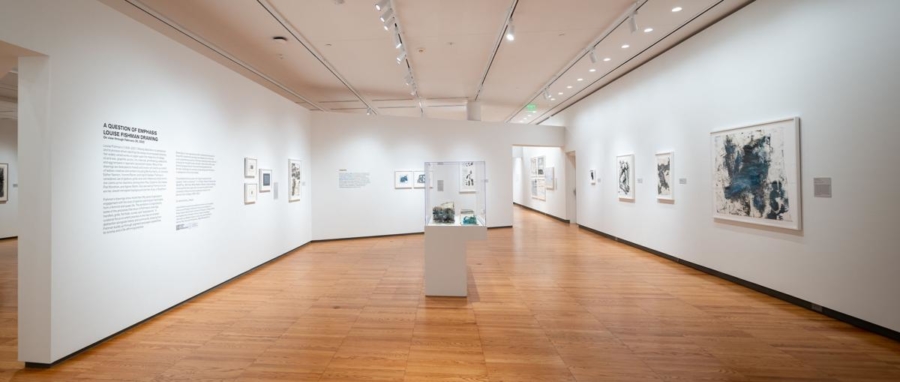September 3, 2021
Download as PDF
View on The News-Gazette

The new Krannert Art Museum Gallery entitled “A Question of Emphasis: Louise Fishman Drawing,” features a deep dive of the 1965 UI MFA graduate and famous painter’s work. Anthony Zilis/The News-Gazette
Louise Fishman’s studio was exactly what you’d expect a prominent New York abstract painter’s workspace to be, Amy Powell said.
Light poured into a large, wide-open room. A cubby by the entrance held tea, which she’d offer to guests. Sometimes, she’d set chairs in front of works she recently completed, eager to discuss them with her visitors. Four years ago, Powell felt lucky to be able to visit the space for the first time.
“It’s very much her space, and she doesn’t let just anyone into her studio,” said Powell, Krannert Art Museum’s curator of contemporary and modern art. “That’s really clear. I felt quite fortunate and cared for.”
Not long before the visit, Powell learned that Fishman earned a master’s degree in fine arts from the University of Illinois in 1965 after Fishman’s wife, Ingrid Nyeboe, called the UI in an attempt to find some of her work.
The paintings were lost to time, but the call sparked a relationship. When she visited the studio, Powell said she felt both excited and intimidated, but Fishman immediately put her at ease.
They ventured next door to her archives, where Nyeboe had organized her wife’s work, some of which had never been shown to the public. While Fishman is known for her large paintings, Powell could see that her other work held value as well. With that, an idea was formed.
“Ingrid and Louise were already quite convinced about the quality and how substantial her works on paper were and that they hadn’t been shown,” Powell said. “They already had the idea of a ‘works on paper’ retrospective. My first time in that archive, I completely agreed that this was something that we really needed to work on, because this work needed to be shown, and it was also teaching us a lot about how we live, about how we make connections with other people, and about how she makes different gestures and kinds of interventions through her works on paper. I was really convinced of that early on.”
Thus began the process of creating a retrospective of Fishman’s work, which is now on display at Krannert Art Museum. For Powell, the process involved several visits to Fishman’s studio, archives and exhibits. Fishman also returned to campus in 2019 to receive a Distinguished Alumni Award and give a lecture.
After a few years of work, Powell finally showed Fishman a catalog for the show earlier this year.
“When she got the first copy of the catalog, she said, ‘I might just be a great artist,’” Powell said. “Which, of course she was a great artist, and she knows it. It was sort of tongue-in-cheek, but also kind of affirming in a way, that she recognized herself in the book. She’s always learning about the work, and that’s been really beautiful.”
The gallery is filled with Fishman’s work, including many well-known paintings, but also plenty that haven’t been shown. It includes drawings, including folded papers that fan out to show individual paintings side by side. Some works show her use of curves, while others show experimentation with different media, including fabric.
Fishman was scheduled to visit the exhibit, but she died unexpectedly July 26 after having heart surgery. When the exhibit was finished, Powell gave Nyeboe a video tour, which she described as “pretty special.”
“It’s been really devastating,” Powell said. “I still have a lot of questions for her. She did see the book. We worked together on the catalogue, and she really loved it. She recognized what the show was doing, and how it was thinking and presenting her works on paper.
“With Louise’s death, being with her work has been the most helpful thing,” Powell added. “Not only is she sort of fully present there, but her work references an attachment to so many other people.”
In all of Fishman’s work, Powell can see her thoughts and feelings, some of which the artist described to her when they sat in front of various paintings and drawings. In one room, an interview with Fishman plays on a television, which can be heard through the entire gallery.
But after her death, Powell decided to give the gallery one more special touch.
At the end of the exhibit is a pencil-drawn self-portrait, with lines, curves and squiggles making out the artist’s face. While Powell always intended on including the drawing somewhere in the gallery, it felt fitting to include it as the viewers’ final impression.
“I think when people pass away and are memorialized, there are often images of them that circulate,” she said. “So, in that way, I thought an image of her took on a profound presence. But I also really see her within the work. She’s in every gesture and the sort of confident conviction with how she’s engaging with the history of abstract painting, with how she’s producing these works that have an incredible effect and dialogue with her cohort of writers and lovers.
“The work already has her presence. So, the exhibition is already doing so much, I didn’t feel like I needed to do anything on top of that to memorialize her,” she added. “I do hope that more people will come through to see and remember her and learn about her work.”



